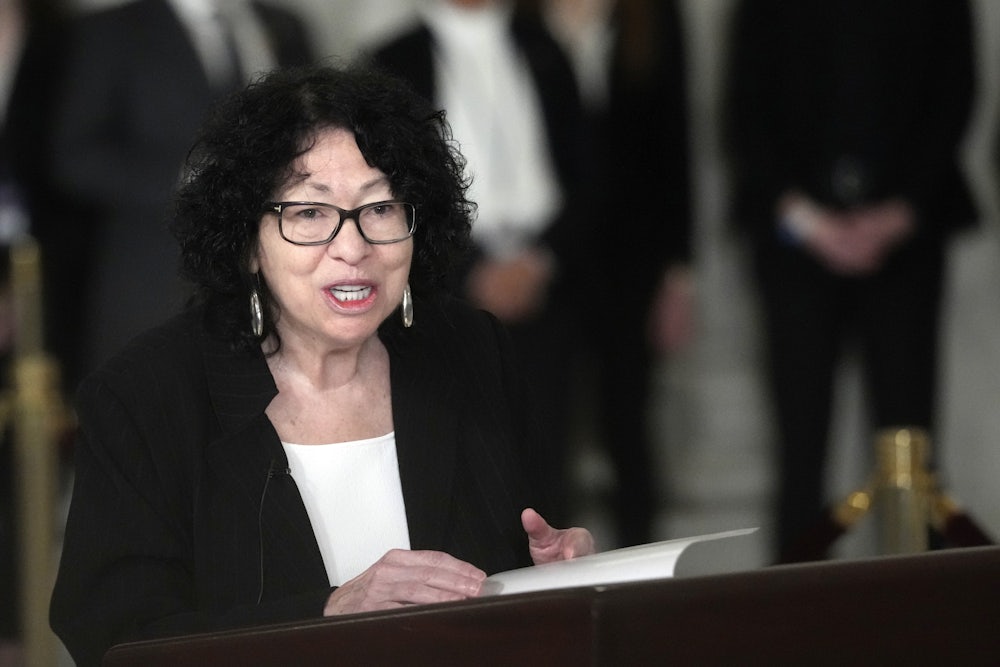The Supreme Court’s current term is winding down, with only a handful of oral arguments left and plenty of opinions to be written. The presidential election is heating up now that Joe Biden and Donald Trump have secured their parties’ nominations. That means it’s time for liberals’ new favorite pastime: pressuring Supreme Court justices to retire.
Former MSNBC anchor Medhi Hasan, who lauded Sonia Sotomayor as the “greatest liberal to sit on the Supreme Court in my lifetime,” urged her to step aside. “With Joe Biden trailing Trump in several swing states and Democrats also in danger of losing their razor-thin majority in the Senate, are we really prepared for history to repeat itself?” he asked. New York magazine’s Jonathan Chait described the decision as “obvious.” Vox’s Ian Millhiser suggested as far back as 2022 that both Sotomayor and Justice Elena Kagan should consider stepping down.
The White House has declined to join those calls, describing Sotomayor’s possible retirement as a “personal decision” and “not something that we get involved in.” Some leading Democratic senators have declined to comment on it as well, reportedly at least in part because they did not like the optics of calling for the first Latina justice to step down. That drew a pointed response from The Atlantic’s Josh Barro last month.
“This is incredibly gutless,” he wrote. “You’re worried about putting control of the Court completely out of reach for more than a generation, but because she is Latina, you can’t hurry along an official who’s putting your entire policy project at risk? If this is how the Democratic Party operates, it deserves to lose.”
But even some senators have suggested that they think Sotomayor should consider the timing of her potential retirement, albeit in macabre terms. “I think she really has to weigh the competing factors,” Connecticut Senator Richard Blumenthal said in an NBC interview earlier this week. “We should learn a lesson. And it’s not like there’s any mystery here about what the lesson should be. The old saying: Graveyards are full of indispensable people, ourselves in this body included.”
I’ve noted before that I don’t write columns on whether individual justices should retire or stay on the court. To put it bluntly, I don’t think they are a good use of my time or the reader’s time. An article urging a Supreme Court justice to retire has an audience of exactly one person, and I would be surprised if that person cared what I have to say on the subject.
But this phenomenon is worth noting for the weakness that it reveals. At the risk of stating the obvious, there is a foolproof way to ensure that Sotomayor’s replacement will share her ideological leanings: Liberals could simply persuade the American people to elect Democrats to the White House and the Senate. If Democrats can’t capitalize on the last few years of right-wing rulings—which have given liberals no shortage of ammunition to criticize the Roberts court’s impact on American life—then Sotomayor is the least of their problems.
There’s an undercurrent of post-traumatic stress to these calls. In 2014, a number of prominent liberals called for Justice Ruth Bader Ginsburg to retire before that year’s midterm election, in which Republicans were strongly favored to win. With Barack Obama in the White House and a Democratic majority in the Senate at the time, Ginsburg’s retirement would have allowed Democrats to confirm a younger, healthier replacement.
Ginsburg rejected those calls at the time. She argued that Democrats wouldn’t actually be able to confirm her successor because the filibuster remained intact for Supreme Court nominees. (Senate Republicans would later scrap it to confirm Justice Neil Gorsuch in 2017.) She also insisted that she was fine. “As long as I can do the job full steam, I think I’ll recognize when the time comes that I can’t any longer,” she said in an interview. “But now I can.”
Republicans captured the Senate that November. Donald Trump’s victory in 2016 then guaranteed that Ginsburg wouldn’t be able to retire under a Democratic president for at least four years. She came close: Democrats eventually recaptured the White House and the Senate in the 2020 elections. But Ginsburg didn’t live long enough to ensure they could appoint her successor. Her death in September 2020 instead allowed Trump and Senate Republicans to place Justice Amy Coney Barrett on the court.
It is hard to overstate the consequences of this series of events. With a 5–4 court, Chief Justice John Roberts could steer the justices through more moderate waters by casting the deciding vote in major cases. Barrett’s confirmation created a 6–3 court where Roberts became marginalized and Justices Clarence Thomas and Samuel Alito took the reins. Roe v. Wade fell less than two years later. A flurry of other hard-right rulings also followed.
Even before Ginsburg died, Trump’s appointments of Gorsuch to replace Antonin Scalia and Justice Brett Kavanaugh to replace Anthony Kennedy had ensured that conservatives would likely control the court for at least a generation. Ginsburg’s death all but cemented it. By some estimates, liberals may not have a chance to appoint a majority of Supreme Court justices until the 2050s. If Barrett stays on the court until she is the same age as Ginsburg, she will serve until at least 2059.
Against this backdrop, liberals have begun urging the oldest member of their voting bloc to retire whenever feasible. Calls for Stephen Breyer to retire emerged almost immediately after Biden was sworn in in 2021. The 83-year-old ultimately announced his decision to step down in January 2022, allowing Democrats to confirm the 51-year-old Ketanji Brown Jackson as his successor. With Breyer gone, Sotomayor naturally became the next one up in the batting order.
It is hard to fault liberals for this attitude, given the seismic effects of Ginsburg’s passing. But her situation was an extraordinary one. By 2014, Ginsburg was 81 years old and had already gone through two bouts with cancer: first with colon cancer in 1999 and then with pancreatic cancer in 2009. The latter sparked the most concern since pancreatic cancer is notoriously hard to detect early and its long-term survival rates are grim. A reoccurence in 2020 ultimately proved fatal.
Sotomayor, by comparison, has not given Americans nearly as much to be worried about with her health. Her only publicly known medical condition is type 1 diabetes, which is not life-threatening if treated properly. She received treatment from paramedics for low blood sugar in 2018, but no other serious incidents have been reported beyond that. As macabre as it may be to point out, at 69 years old, she has not even reached the average U.S. life expectancy yet.
Other justices have had much greater health scares over the years. Roberts, for example, was hospitalized overnight for a fall he suffered at a country club in 2020. He previously suffered major seizures in 1993 and 2007. Thomas, who is 74 years old, spent a week in the hospital in 2022 for an unspecified infection with “flu-like symptoms,” according to the court. Serious medical problems can arise suddenly and without warning, of course. Antonin Scalia had no publicly known health issues before he died suddenly in his sleep during a hunting trip in 2016. But that is as true for the other eight justices as it is for Sotomayor.
If anything, it may be Scalia’s death that is the most instructive here for liberals. His death was a potential ideological turning point for the court in the other direction. If Obama had been able to confirm a replacement, it would have given the high court its first liberal majority since the 1960s. Not only would it have secured the future of precedents like Roe, but it also would have allowed liberals to break new ground on civil rights, worker protections, LGBT rights, and more.
Conservatives reacted to this potential existential threat in two ways. First, Mitch McConnell and other Republican senators refused to confirm any nominee that Obama put forward. Second, they mobilized their voting base. Trump vowed multiple times that he would appoint “pro-life” judges and justices. He released short lists of potential Supreme Court nominees to secure major endorsements. He claimed that Hillary Clinton would “abolish” the Second Amendment if elected. “By the way, if she gets to pick her judges, nothing you can do, folks,” Trump warned at an August 2016 rally.
Trump’s strategy worked. Fear of a liberal Supreme Court majority allowed Trump to consolidate a GOP electorate that was still somewhat skeptical of him at the time. A CNN exit poll in 2016 found that Trump won 56 percent of voters who said that the Supreme Court was the most important factor in their vote. Clinton, on the other hand, only narrowly won among voters who said it was an important factor and a minor factor.
If Democrats want to ensure that Sotomayor’s replacement is a liberal, then they can and should make an equivalent case to the voters themselves. It should be easy since the Supreme Court has already done half of the job for them. Democrats did better than expected in the 2022 midterms in large part because of the backlash to the Supreme Court overturning Roe. Right-wing rulings on the abortion pill, IVF access, gun control, and other issues should also be easy to mobilize voters around.
Biden himself knows how effective these tactics can be. His presidential campaign almost fell apart in 2020 before he won South Carolina, buoyed by Black voters’ support and the endorsement of the influential Representative Jim Clyburn. Biden won that support in part because he promised to appoint the first Black woman to the Supreme Court if elected—a pledge he fulfilled in 2022 by nominating Jackson to replace Breyer.
Naturally, Democrats need to be realistic and honest about what can be achieved. Most of the party’s elites—Biden included—are profoundly averse to the more radical solutions that some court reformers have proposed. Suffice it to say, there won’t be a viable way to pack the high court anytime soon, as some liberals previously sought. But recent events have demonstrated why holding the ground you have is so important. A lot can happen in four years; Democrats have the opportunity to assure voters that they’ll be ready to act when opportunity presents itself.
There may never be a better election year than this one for Democrats to make judicial nominees a centerpiece of their campaign. Biden could even adopt some of Trump’s 2016 tactics. Releasing a short list of Supreme Court nominees for a future vacancy would make it more tangible for supporters, as it did for Trump. And while presidents would, ideally, not promise specific outcomes in cases from their nominees, Trump already let that genie out of the bottle.
I do not begrudge liberals for focusing on strategic retirements after Ginsburg. And if Sotomayor’s health takes a sudden and serious turn for the worse in the next few months, she should consider stepping aside. But the real lesson of the Trump era is that pressuring individual justices to retire is no substitute for making the case to voters about control of the Supreme Court. The best way to ensure that Sotomayor (or Kagan, or Jackson if you’re really pessimistic) retires under a Democratic president and a Democratic Senate majority is to elect them.










